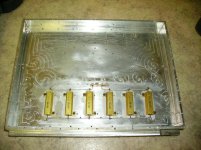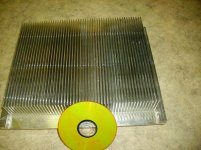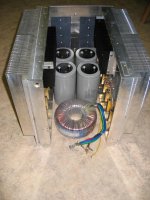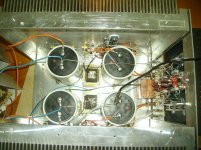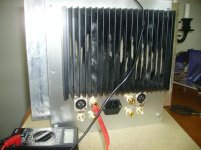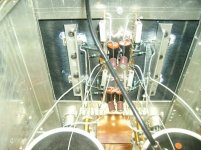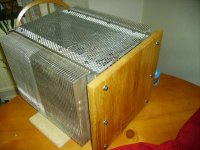Good evening!
After years of junkyard digging I´ve finally gathered all the stuff I need to build the world weirdest amp, the dreaded Son of Zen!!
The X:ed, current sourced version to be more precise.
To make a long story short:
I have two kinds of mosfets in stock to choose between; IRFP260N and 75645P. Both are high power, high current devices with seriously high Ciss (around 4000pF).
My question is: Would it be a good idea to cascode the whole thing and use smaller mosfets (IRF530 or something) in the lower position?
I´m a bit paranoid when it comes to input capacitance and I´m really fond of the idea of cascoding even though I´d loose some output swing.
I should also mention that this will be a downsized version, there is no way my heatsinks can dissipate 375W or whatever the original circuit runs at.
After years of junkyard digging I´ve finally gathered all the stuff I need to build the world weirdest amp, the dreaded Son of Zen!!
The X:ed, current sourced version to be more precise.
To make a long story short:
I have two kinds of mosfets in stock to choose between; IRFP260N and 75645P. Both are high power, high current devices with seriously high Ciss (around 4000pF).
My question is: Would it be a good idea to cascode the whole thing and use smaller mosfets (IRF530 or something) in the lower position?
I´m a bit paranoid when it comes to input capacitance and I´m really fond of the idea of cascoding even though I´d loose some output swing.
I should also mention that this will be a downsized version, there is no way my heatsinks can dissipate 375W or whatever the original circuit runs at.
Attachments
Well, since nobody had an opinion I ditched the cascode idea and ordered some IRF640´s to build the amp as drawn in Nelsons article. IRF640 seems lite a good compromise between capacitance and power handling.
I´ll use 470R/4,7k inte the feedback "loop" and 120uF low impedance input caps bypassed with 1,5uF polyprops.
The PSU consists of 2 x 66 500uF and 1 x 1,1mH 10A choke per channel, the transformer will be either 2x18V 600VA or 2x24V 750VA depending on how much the heatsinks can handle, this will be subject for some experimentation later on.
I´ll use 470R/4,7k inte the feedback "loop" and 120uF low impedance input caps bypassed with 1,5uF polyprops.
The PSU consists of 2 x 66 500uF and 1 x 1,1mH 10A choke per channel, the transformer will be either 2x18V 600VA or 2x24V 750VA depending on how much the heatsinks can handle, this will be subject for some experimentation later on.
Attachments
darn it fuling,
I should have caught your post earlier. Sorry. I'm very interested in your cascode ZV7. Can you post a schematic?
I like the idea of using small fet's in order to reduce distortion. Less wattage is no problem with midrange/hi frequency horns.
If you are still feeling inclined, I'd love to see what you were up to.
John
I should have caught your post earlier. Sorry. I'm very interested in your cascode ZV7. Can you post a schematic?
I like the idea of using small fet's in order to reduce distortion. Less wattage is no problem with midrange/hi frequency horns.
If you are still feeling inclined, I'd love to see what you were up to.
John
I can post a schematic later today.
The reason I gave up on the cascodes had more to do with lack of space for the extra heatsinks than lack of replies.
It´s not impossible that I´ll change the circuitry later but I´ll follow the basic conscept to begin with.
My future BZLS will definitely be cascoded though!
The reason I gave up on the cascodes had more to do with lack of space for the extra heatsinks than lack of replies.
It´s not impossible that I´ll change the circuitry later but I´ll follow the basic conscept to begin with.
My future BZLS will definitely be cascoded though!
Power Jfets would be sweet but I don´t have any.
As I mentioned I´ll finish this amp as in the ZV7 article at first, later on I might experiment with cascoding.
It pretty much depends on how much room there will be left inside the chassis, how much work it will involve to tear it apart to make the changes and how much power the heatsinks can handle.
To make the cascodes work I would have to raise the rail voltage = more heat to deal with.
With the transformers I have at hand I can choose between 24 and 32V rails, the lower figure will probably be ok without cascodes and the higher would lead to a significantly higher temperature... I´m expecting about 4A total bias per channel, so only a few extra volts means big changes in dissipated power.
Though I still find the idea of cascoding very attractive and if I don´t do it in this amp I´ll definitely try it out in the future in a more efficient circuit.
I have a bunch of 112mH 2A iron core chokes waiting to be put to use in some inductor loaded amp soon...
As I mentioned I´ll finish this amp as in the ZV7 article at first, later on I might experiment with cascoding.
It pretty much depends on how much room there will be left inside the chassis, how much work it will involve to tear it apart to make the changes and how much power the heatsinks can handle.
To make the cascodes work I would have to raise the rail voltage = more heat to deal with.
With the transformers I have at hand I can choose between 24 and 32V rails, the lower figure will probably be ok without cascodes and the higher would lead to a significantly higher temperature... I´m expecting about 4A total bias per channel, so only a few extra volts means big changes in dissipated power.
Though I still find the idea of cascoding very attractive and if I don´t do it in this amp I´ll definitely try it out in the future in a more efficient circuit.
I have a bunch of 112mH 2A iron core chokes waiting to be put to use in some inductor loaded amp soon...
I switched to air-core chokes in the ZV7 and think they sound better than iron. My 28.5 volt supply dropped to 23 volts after the chokes. As a result, the amp runs pretty cool, though the chokes are rather warm. The sound is stunning.
btw: I cross the amp at 500hz, and have downsized the choke in order to take advantage of the limited frequency range. This saves money and offers less coil resistance.
According to Nelson's distortion graph, the choke loaded ZV7 only has 0.15 percent harmonic distortion at three watts output. This makes for one fine sounding amplifier!
John
btw: I cross the amp at 500hz, and have downsized the choke in order to take advantage of the limited frequency range. This saves money and offers less coil resistance.
According to Nelson's distortion graph, the choke loaded ZV7 only has 0.15 percent harmonic distortion at three watts output. This makes for one fine sounding amplifier!
John
I´ve been looking at the ZV7-T for a while but I don´t think my chokes are suitable for balanced operation, centertapped ones would be better.
I have another circuit including one P-channel Mosfet and one N-channel Jfet that has been tested with my chokes and it worked very good, maybe I´ll build a 4x12W SE amp this way for my biamped TB speakers. Just for fun as a side project.
Well well, all I can do right now is waiting for the components to the Xsoz to arrive.
Meanwhile, I can always study some preamp circuits to find something to match the beast
I have another circuit including one P-channel Mosfet and one N-channel Jfet that has been tested with my chokes and it worked very good, maybe I´ll build a 4x12W SE amp this way for my biamped TB speakers. Just for fun as a side project.
Well well, all I can do right now is waiting for the components to the Xsoz to arrive.
Meanwhile, I can always study some preamp circuits to find something to match the beast
The amp is now almost complete, all that´s left to assemble is transformer, rectifiers and front & top plates.
I´m currently running some tests with 24V bench PSU´s and everything seems fine, the heatsink for the mosfets gets quite hot but not dangerously so. The main heatsinks only gets comfortably warm, which is good since the PSU caps are mounted very close to the power resistors.
I´m currently running some tests with 24V bench PSU´s and everything seems fine, the heatsink for the mosfets gets quite hot but not dangerously so. The main heatsinks only gets comfortably warm, which is good since the PSU caps are mounted very close to the power resistors.
Attachments
Nice job, fuling. BTW, those heatsinks of yours are just amazing!
Regarding the choke load, I noticed that in my ZV7-T an air-core choke draws quite a bit of the load--which seems to remove stress from the rest of the circuit. This leaves more capacity for the heatsinks, and you could cascode with less rail voltage. I only loose 5.5 volts across the chokes.
Just something to gnaw on,
John
Regarding the choke load, I noticed that in my ZV7-T an air-core choke draws quite a bit of the load--which seems to remove stress from the rest of the circuit. This leaves more capacity for the heatsinks, and you could cascode with less rail voltage. I only loose 5.5 volts across the chokes.
Just something to gnaw on,
John
Thanks!
I DO like choke loading, but since I don´t have any suitable centertapped chokes nor any equipment to measure distortion the ZV7-T is not of any particular interest for me.
Both when I´m working with tubes and transistors I have a preference for "pure" SE topologies and thus airgapped iron wares.
A friend once came to this conclusion: "The sound is in the airgap"
Considering what happens with an iron cored choke or transformer when you put an airgap in the core there might be some truth in his statement, the inductance decreases but also gets more linear. There is also theories about the benefits of moving away from the "zero flux point" or whatever it´s called, I guess the magnetization curves could be compared with the bias current in an amplifier.
The greatly improved efficiency is another great thing about inductive loading, I once made an SE amp that delivered over 2x30W with only 75W losses per channel.
If I ever need more than, say, 20W class A I´ll definitely use inductive loading. The idea of using bifilar output transformers to get rid of the output caps has also crossed my mind.
I DO like choke loading, but since I don´t have any suitable centertapped chokes nor any equipment to measure distortion the ZV7-T is not of any particular interest for me.
Both when I´m working with tubes and transistors I have a preference for "pure" SE topologies and thus airgapped iron wares.
A friend once came to this conclusion: "The sound is in the airgap"
Considering what happens with an iron cored choke or transformer when you put an airgap in the core there might be some truth in his statement, the inductance decreases but also gets more linear. There is also theories about the benefits of moving away from the "zero flux point" or whatever it´s called, I guess the magnetization curves could be compared with the bias current in an amplifier.
The greatly improved efficiency is another great thing about inductive loading, I once made an SE amp that delivered over 2x30W with only 75W losses per channel.
If I ever need more than, say, 20W class A I´ll definitely use inductive loading. The idea of using bifilar output transformers to get rid of the output caps has also crossed my mind.
I tested the Xsoz in my system for the first time last night, unfortunately there was some hum which might have come from from my "10 minutes preamp" made of a volume pot, two IRF9610 and four resistors (a ZV4 buffer actually).
When I connected the amp (open inputs) to a pair of speakers with 87dB sensivity there was absolutely no hum to be heard, but with 94dB speakers and the preamp connected there was some hum that could be heard up to about two feet away from the speakers.
Not much, but enough to be a bit annoying.
I won´t say anything about the sound until I´ve heard the amp with a proper balanced preamp, the CCS is adjusted for balanced input and I suspect that it doesn´t work very well with SE input signal.
Not that there was anything wrong with the sound, but I´m expecting severe improvements with a decent preamp.
Nothing wrong with the ZV4 buffer, but the PSU I used and my hardwiring work left a lot to wish for
When I connected the amp (open inputs) to a pair of speakers with 87dB sensivity there was absolutely no hum to be heard, but with 94dB speakers and the preamp connected there was some hum that could be heard up to about two feet away from the speakers.
Not much, but enough to be a bit annoying.
I won´t say anything about the sound until I´ve heard the amp with a proper balanced preamp, the CCS is adjusted for balanced input and I suspect that it doesn´t work very well with SE input signal.
Not that there was anything wrong with the sound, but I´m expecting severe improvements with a decent preamp.
Nothing wrong with the ZV4 buffer, but the PSU I used and my hardwiring work left a lot to wish for
Interesting news, fuling. I'm anxious to read a review of your amp with a balanced input.
I'm at the point where I get to fire up my second ZV7-T--today, is my goal. It, too, has the ZV4 buffered input. I'm hoping it performs well. I did match the ZVP3310 mosfets, so there should be some noise cancellation. Also, with the loop feedback routed to the buffer input, there should be even greater distortion reduction--that's assuming I have implemented my design with a proper understand of Nelson's reasoning.
I think the ZV7 version of the SOZ is an amazing sounding amp. It's nice to see someone else working along a similar line.
John
I'm at the point where I get to fire up my second ZV7-T--today, is my goal. It, too, has the ZV4 buffered input. I'm hoping it performs well. I did match the ZVP3310 mosfets, so there should be some noise cancellation. Also, with the loop feedback routed to the buffer input, there should be even greater distortion reduction--that's assuming I have implemented my design with a proper understand of Nelson's reasoning.
I think the ZV7 version of the SOZ is an amazing sounding amp. It's nice to see someone else working along a similar line.
John
The ZV4 buffer is a very clever way to implement a buffer with a single rail voltage and input at ground level, very useful!
As far as I can see there is no reason not to use a CCS in the tail of any SoZ-version instead of the power resistors, the efficiency goes up and so does the performance!
As far as I can see there is no reason not to use a CCS in the tail of any SoZ-version instead of the power resistors, the efficiency goes up and so does the performance!
"The Beast" is finished!!
Right now it´s warming up for a listening session later today, and the hum went away when I got the bright idea rolleyes: ) to put jumpers between -in and ground in the XLR inputs. I forgot that at the first listening session, hence the hum that I blamed on the external buffer.
rolleyes: ) to put jumpers between -in and ground in the XLR inputs. I forgot that at the first listening session, hence the hum that I blamed on the external buffer.
Right now it´s warming up for a listening session later today, and the hum went away when I got the bright idea
Attachments
- Status
- This old topic is closed. If you want to reopen this topic, contact a moderator using the "Report Post" button.
- Home
- Amplifiers
- Pass Labs
- Cascoded ZV7
